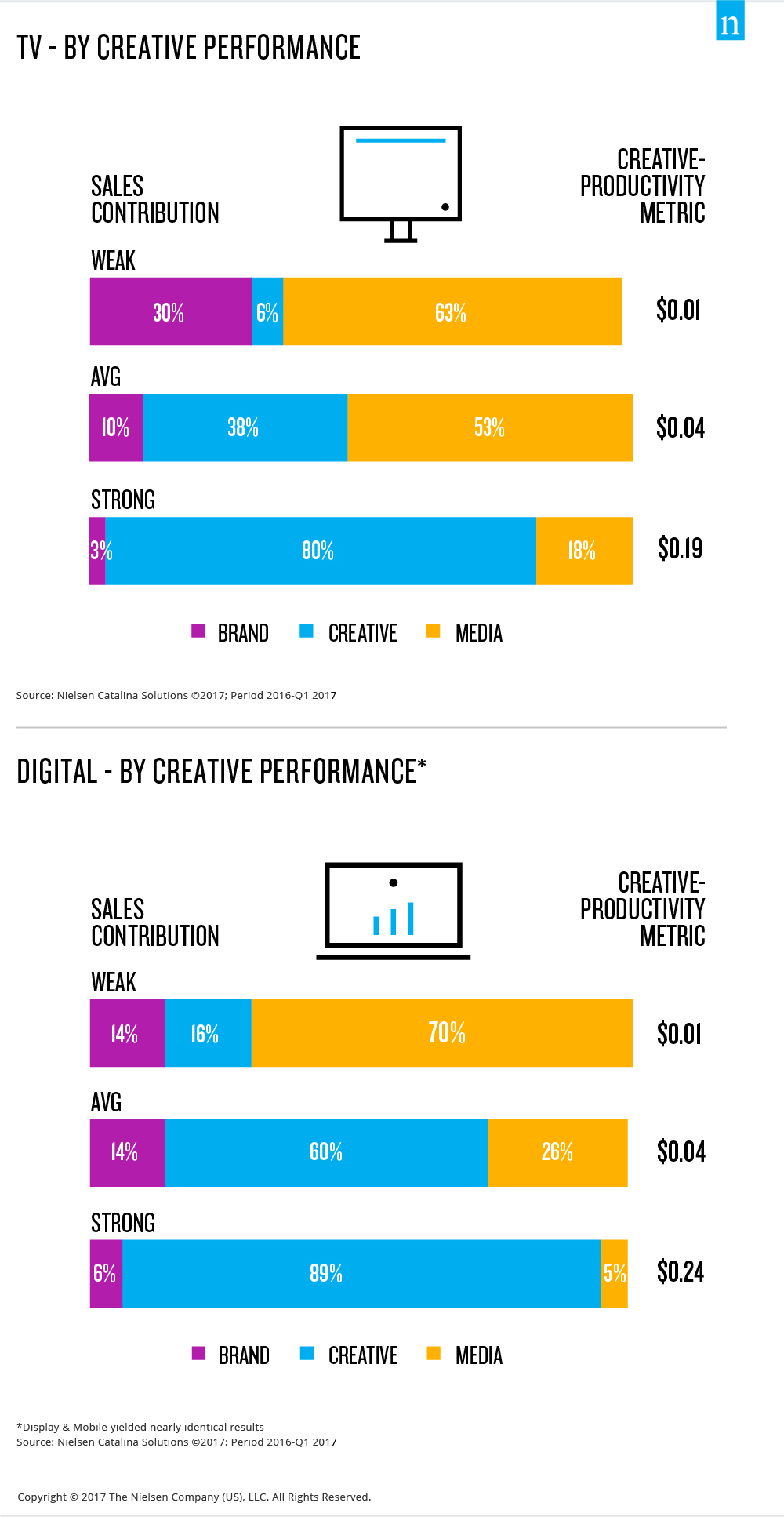 最近的一个上午,我们在办公室里即兴讨论了什么是优秀的广告。我们讨论了几个我们最近最喜欢的广告,可以想象,关于哪个广告最好的建议范围很广。短广告和长广告。有趣的和感伤的。产品驱动型和品牌聚焦型。理性的和感性的。虽然这些广告的长度和目标各不相同,但有一点是明确的:它们都是 "必须观看 "的广告--不是节目间歇的填充物,而是我们想要谈论、分享和反复观看的优秀创意。
最近的一个上午,我们在办公室里即兴讨论了什么是优秀的广告。我们讨论了几个我们最近最喜欢的广告,可以想象,关于哪个广告最好的建议范围很广。短广告和长广告。有趣的和感伤的。产品驱动型和品牌聚焦型。理性的和感性的。虽然这些广告的长度和目标各不相同,但有一点是明确的:它们都是 "必须观看 "的广告--不是节目间歇的填充物,而是我们想要谈论、分享和反复观看的优秀创意。
当我回顾尼尔森卡塔琳娜解决方案公司(NCS)和尼尔森公司联合开展的一项新研究项目的结果时,我意识到了优秀创意的重要性。研究结果强化了一个古老的广告观点:创意为王!创意是推动我们参与、分享、谈论、辩论、记忆和购买的动力。创意具有强大的力量,无论它在何时何地以何种方式出现。例如,苹果公司 1984 年推出 Macintosh 电脑的广告至今仍是最受关注的广告之一,而它只在全国电视上播出过一次。
该研究试图量化五大广告效果驱动因素的销售贡献:创意、到达率、目标定位、重复性和情境。研究结果显示了这些驱动因素之间的相对平衡随着时间的推移发生了怎样的变化,以及如何在电视和数字渠道中发挥作用。最让我感兴趣的是,研究结果表明,创意质量对品牌在市场上取得成功的贡献与所有其他因素的总和一样大。此外,研究还发现,当创意强大时,它是市场成功的压倒性驱动力:传统电视广告和数字广告的这一比例分别高达 80% 和 89%。反之,如果创意不强,电视和数字广告的销售提升就会很弱,其他媒体因素才是主要驱动力。
简而言之,无论是传统电视还是数字平台,优秀的创意仍然是任何广告活动取得成功的最重要因素。新的工具和技术可以增强、扩大和更好地锁定目标受众,新的形式和目的地似乎每天都在出现,以帮助广告商找到他们的消费者。但在推动真正成功的广告活动方面,这些工具和技术根本无法与优秀创意所带来的力量相提并论。

This, of course, raises several questions: What is great creative? How do marketers know if their creative is “great?” And how do they achieve great success with it?
In the past, marketers have relied on qualitative and/or quantitative self-report copy testing to evaluate creative. Essentially, they made decisions based on biased consumer responses often aided by their professional eyes and instincts. Essentially, they went with what they thought would work. While this may have kept very poor advertising off the air, it left some potentially great work on the drawing board. And if they had a piece of creative they needed to cut down/compress, they might have relied on personal judgment.
This is where consumer neuroscience increasingly plays an important role for marketers. That’s because the current suite of tools combining EEG, eye tracking, facial coding and biometrics, along with self-report surveys, offer a unique opportunity. Not only can these tools measure and evaluate on a macro level (i.e., what works and what doesn’t), they go even deeper, providing moment-by-moment insight that can pinpoint where a spot(s) needs to be adjusted. The results enable a collaborative approach between marketers, creative agencies and researchers to help go from early stage to primetime success—avoiding the cutting-room floor that has claimed too many could-have-been-great ads. This is because consumer neuroscience measures what traditional research methods cannot. Methods like surveys can only tap into our conscious responses, which we know are often heavily biased and are only one, arguably smaller, component of how we consume media. Studies have shown that the majority of our decision-making happens non-consciously, so much of what drives everyday decisions—including what we’ll purchase, watch and talk about—requires tools that can measure these responses.
Several years ago, we developed a model designed to understand the explosion in content platforms and the types of creative that can be optimized for each. Our Brand Immersion Model became a framework for defining the relationship between the immersive platform of TV and digital’s flexible platforms. Our research found that TV, through its unmatched ability to create new, unconscious emotional connections, has the power to form need states—which make consumers receptive to brand messages—where none existed before. Flexible environments play a key role in reinforcing need states. So the two work together in powerful, synergistic ways.
It’s important to understand this relationship in order to develop creative that will be great on each platform. The Brand Immersion Model breaks down the two primary ways to engage with content:
Highly Immersive Platforms: Viewers are more apt to be passive participants, observing content that substitutes the viewers’ emotional state with the emotional lives of the onscreen characters. If those characters need a product, the viewer feels that same need. Examples include television, virtual reality, theaters and home theaters, IMAX and events like the Olympics. Immersive content enables us to experience others and generate need states that previously did not exist.
Highly Flexible Platforms: Viewers are more apt to be active participants, constantly searching for something that engages them. This content requires the need to already become established. The content or advertising then supports this need. Examples include smartphones and tablets with email, social media and the websites that provide a never-ending search for more. Flexible content enables us to develop our own experience and satisfy need states that already exist.
Television is highly effective as an advertising platform because it is the primary medium that can create a need state, either through experiencing the needs of the onscreen characters during the primary content or through the high emotional involvement with on-screen characters during the advertising itself.
With flexible experiences, individuals seek out an experience more customized to their interests. For the most successful executions, this can result in higher engagement with content than on an immersive platform because it’s tailored to what the consumer is seeking. The reason for this heightened engagement is that the content is user-generated—people seek to broaden their conversations with each other and trusted sources like influencers instead of with the stories of new characters in an advertisement. Unless the ad is for a product the consumer already knows that he or she wants at that moment and it takes up enough of the screen to get noticed without turning the viewer “off,” it cannot generate the same level of connection.
So how do you ensure that your creative and different platforms go hand-in-hand for the most optimal engagement? How can we move from must-skip to must-watch? And how do we turn turn-out into tune-in? It’s simple: tap into the full spectrum of consumers’ responses— both conscious and non-conscious—to uncover areas of emotional impact, visual hot spots, blind spots and inform the strongest possible creative development.



